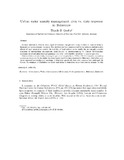| dc.contributor.author | Gwebu, T.D. | |
| dc.date.accessioned | 2010-06-08T13:56:03Z | |
| dc.date.available | 2010-06-08T13:56:03Z | |
| dc.date.issued | 2002 | |
| dc.identifier.citation | Gwebu, T.D. (2002) Urban water scarcity management: civic vs. state response in Bulawayo, Habitat International, Vol. 26, pp.417–431 | en_US |
| dc.identifier.issn | 0197-3975 | |
| dc.identifier.uri | http://hdl.handle.net/10311/495 | |
| dc.description.abstract | In most sub-Sahara African cities, rapid urbanization has placed a heavy burden on available human,
financial and socioeconomic resources. The problem has been compounded by the intricate and interactive
effects of rapid population growth, the inability of local authorities to handle the increasingly complex
functions of metropolitan management, centralization of decision-making by Central Governments,
economic structural adjustment programmes, and even unfavourable variations in weather patterns.
This is a historical case study, covering the period of roughly from 1989 to 1995. It is based on secondary
sources, participation by the author in water supply feasibility investigations for Bulawayo, Zimbabwe, and
views expressed in stakeholders’ meetings. It illustrates specifically how civic response has challenged the
Central Government of Zimbabwe to review and revise its long-term water provisioning strategy for this
municipal authority. | en_US |
| dc.language.iso | en | en_US |
| dc.publisher | Pergamon, www.elsevier.com/locate/habitatint | en_US |
| dc.subject | Urbanization | en_US |
| dc.subject | Water | en_US |
| dc.subject | Centralization | en_US |
| dc.subject | Self-reliance | en_US |
| dc.subject | Public participation | en_US |
| dc.subject | Bulawayo | en_US |
| dc.subject | Zimbabwe | en_US |
| dc.title | Urban water scarcity management: civic vs. state response in Bulawayo | en_US |
| dc.type | Published Article | en_US |

